 Above: Otto Linton in the rare 2000S OSCA serial number 2006.
Above: Otto Linton in the rare 2000S OSCA serial number 2006.
Special Notice:Otto Linton will be the guest speaker at a VSCCA Luncheon, December 4th, in Somers NY. Contact frankrighetti33@aol.com for details.
“I raced an MG in 1948 at Watkins Glen,” says driver Otto Linton. “It was a J4, the only one in the United States and it’s now back in the UK. “ As described in the book The Story of the MG Sports Car, the 1933 J4 was “too fast for most drivers.” The car had essentially the same body that would cover MG frames until 1955, except no doors. Mechanically, it had a 4-cylinder OHC engine of 750cc displacement, supercharged, with one large SU carburetor and a four speed transmission with a remote shift lever and lock-out reverse. It was built in 1933 in a special production of only 9 cars, at the same time as the more famous K3 Magnette with the same design engine but of 6 cylinder configuration – 30 of these were built and only sold to customer competition drivers.
Like many other drivers in that first race of the new sports car era – Bill Milliken, race organizer Cam Argetsinger, Denver Cornett and George Weaver, Otto posted a DNF in the event, with Haig Ksayian going on to take the win in the MG class. “I just had that one race in ’48,” says Otto, “plus a couple of hill climbs in 1949.”
“I drove all of the street races at Watkins Glen,” notes Otto, “except for 1950. That year I built the car that Denny Cornett drove. It was a DuPont Indianapolis car with a B Type engine. But we didn’t get all the engine parts so I installed a Mercury V-8, the full-size one, not the V-8 60. It raced as the Speedcraft Special in 1950 and I was in his pit crew.
In 1951 Otto drove Tony Pompeo’s Siata. The Siata Otto is talking about was the prototype of the Siata Spider. As such, it had a tubular steel frame instead of the heavier platform frame. It was lighter by 200 pounds but it had a somewhat more curvy body, compared to the production Siata Spiders, which looked like Type 166 Ferraris in miniature.
This car, originally called the Siata “Amica” was re-named the model 300BC for its short production run. Both cars had aluminum bodies and a Siata-tuned suspension. Linton drove the car for Pompeo at Watkins Glen and Elkhart Lake in 1951. Then he bought it minus its Crosley engine, replacing it with a Crosley engine he had modified, built and tuned. Otto raced it at Vero Beach and Sebring, Florida and his English mechanic wrecked the car at Bridgehampton in 1953. It was sold and later rebuilt.
In 1952, Siata was building a beautiful new car with a 2-liter V-8 engine and 4-wheel independent suspension, and Otto ordered one. It was a 208CS coupe with a Stablimenti Farina body and whale-tooth grille. “My 208 was the first one to come into the United States because I went to Torino pick it up and have it shipped as personal belongings, arriving just a few days before the 1952 Glen where I had it entered. His car, #114, never raced there. Like all the other cars it was stopped after the fatal accident that year. Then Linton drove at the 1953 Bridgehampton and Watkins Glen second course, handily waxing all of the Jag XK-120s and winning his race. “For some reason, they always put me in with the Jags,” Otto laments. The 208 was always driven to and from the races like a real sports car. That included most of the SAC races, earning a few 2nd places to Lunken’s Ferrari race car. Driving the 1953 McDill AFB race at Tampa, Fla., Linton took 2nd to Lunken and co-driver Chuck Hassan in the E-Modified class, with Linton driving the 6-hours solo.
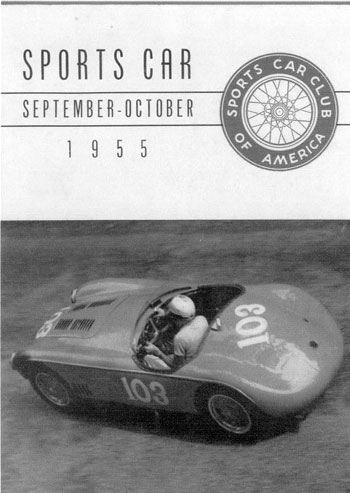
Alix Lafontant photo of Linton in the ex-Cabianca OSCA at Brynfan Tyddyn. Alix captioned the picture 'Man at Work'.
For 1954, he acquired the well-known early OSCA s/n 1114, owned and raced by the famous Italian driver Giulio Cabianca. This OSCA was a little different from the Mt-4 models we usually see. It had headlights inside the grille and two-tone paint scheme of dark blue on top and red between the wheel wells. It was in class F but not up to the 1500cc limit – only 1342cc. Nevertheless, he won the Brynfan Tyddyn races of 1954 and 1955 with it. Alix Lafontant, the great racing photographer, took a wonderful picture of the car by crawling out on a tree branch overhanging the course, pre-focusing his Leica IIIF and setting the shutter for 1000th of a second. In this picture, which is gracing the cover of the Sept/Oct 1955 issue of Sports Car, the SCCA magazine, we see that Otto’s tach is at 7000 rpm. In the 1956, race, Otto had to settle for 3rd place because Carroll Shelby and Jack McAfee were 1st and 2nd, driving a 2 liter Ferrari and a 1500cc Porsche 550-RS Spyder. Read “The Winningest OSCA”.
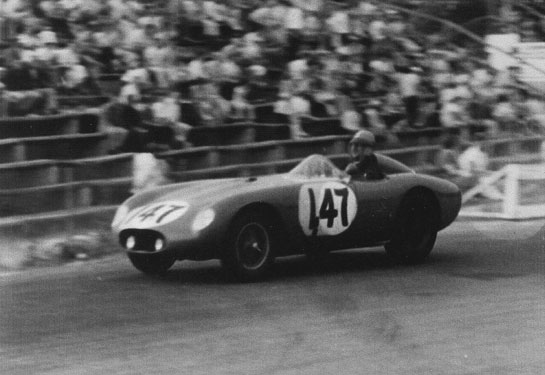
June 8th 1958 with OSCA TN sn 1178. Linton had just come from Sebring where he won his class and did it again at Marlboro in June.
From 1957 to 1963, there followed a number of wins, 2nds, and 3rds driving the 750, Mt-4, TNS and 2 liter OSCAs at Sebring, Watkins Glen, Marlboro 6 hours, Vineland 4 Hours and regional races. “The TNS was the new version of the Mt-4,” says Otto. “It had the same chassis as the Mt-4 but it had a 1498cc engine with a different head. It had twin ignition and more power. It was a real, real good car. We ran that at Sebring and we won the Marlboro race overall.” In 1957, the TNS was a factory entry in the 12-Hour race, with Otto, Harry Beck and Hal Stetson driving. They finished 3rd in the 1500cc sports racing class, after two Porsche 550s. In 1958, again with a factory entry, Linton, Beck and Stetson finished Sebring 1st in the 1500cc class and 13th overall. Otto had joined in a business relationship with Lou Flink, who was continually selling off cars. The OSCA TNS had come from Jim Kimberly and it went to a fellow who was going to put a Ford V-8 in it. When the car was later restored, the special dual ignition head was missing. John Milos originally owned the TNS and all the trophies went to him. He’s since died and no one knows where the trophies are. In 1964 at Sebring, Otto and co-driver Thomas Fleming placed 1st in the GT8 class with Fleming’s 2 liter Abarth Simca. and 24th overall, right after A.J. Foyt and John Cannon in the Corvette Gran Sport. Linton also scored wins at Watkins Glen and the Bahamas in this car.
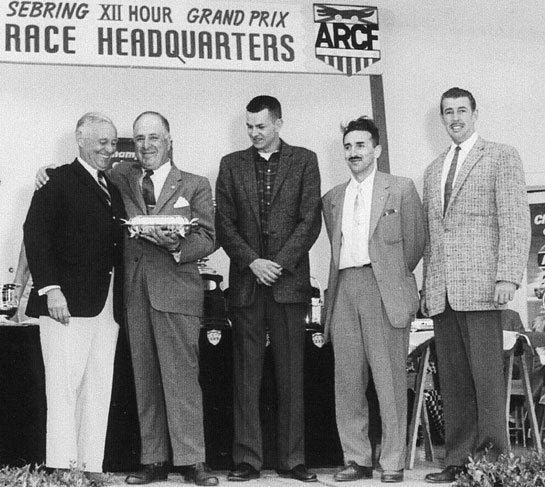
Awards time, Sebring, 1958. Left, Alec Ulmann, Edgar Fronteras, Harry Beck, Otto Linton and Hal Stetson.
In 1967, Otto began to phase out of racing. “I was expanding my business,” he says, “and I was getting a loan from the Small Business Administration. I had to turn in my license to SCCA or they wouldn’t issue insurance. So after that I could only do local races that didn’t require a license. I bought a Bobsy with an OSCA engine from a guy in Wyoming. But there was something about it that would seize up the main shaft of the transmission. We later concluded that the bronze pilot bushing should have been a needle bearing. I stopped racing after I sold that car.”
From They Started in MGs: Profiles of Sports Car Racers
of the 1950s © 2011 Carl Goodwin by permission of McFarland & Company, Inc., Box 611,
Jefferson NC 28640. www.mcfarlandpub.com.
All photos courtesy of Otto Linton (not all appear in the book “They Started in MGs”)
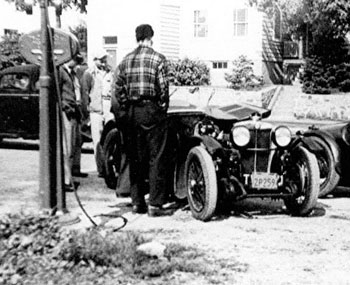
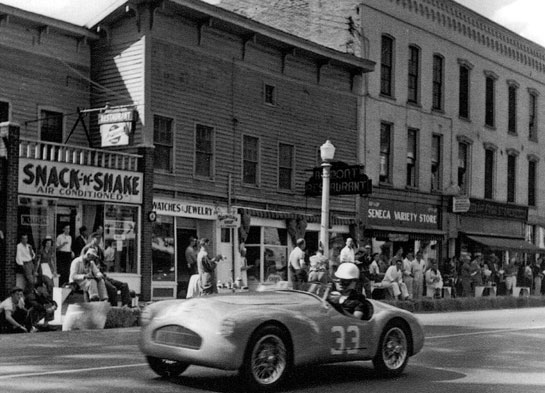
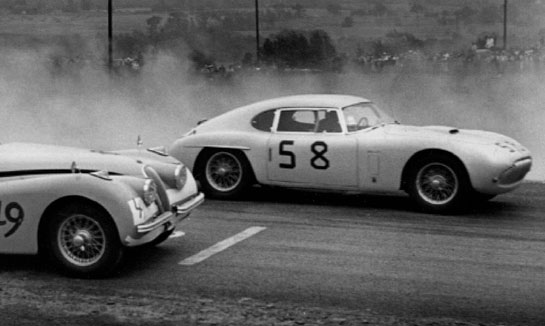
well i do remember the 2-litre, they had it down to vineland several times.
it was blindingly fast on the main straight but sort of a beast in the corners with the front weight bias, bob holbert in the RS was all over him in the turns in spite of 4oo cubes less displacement.
my first acquaintance with otto was in class HM at the glen in 1960, i had the new 187 engine with 64 mm bore & he had the older type which was 62 square. with my advantage of 5 hp there was really no contest but of course ollie schmidt with the lightweight lola beat us both.
> jack
Just thought you might like to know I owned the Simpson Special with OSCA engine No. 1113 which was raced in Marlboro by Captain Capi Capiello .That engine was also a factory model as raced by Giulio Cabianca.It was also used in his record breaking car in the 1000 cc class.
Respect for Mr.Linton and the OSCA 2000.a car with fine engeneeringfrom the Maserati brothers.
We are restoring OSCA 2000S s/n2004,a car that was raced 1961 in the SCCA Colorado
region by Roy Cherryhomes,Ron Hunter,white colour and with a tweeked corvette engine developed by Gary Knutson.
Does anybody still remember the car or has some info for us?
Mr Troesser
I remember Ron Hunter’s Osca. I used to occasionaly pit for him. I believe his crash with Chuck Sargents Birdcage July 1961 pretty well ended his racing the Osca.
Nice article about Otto Linton. Noticed a small error in the last caption, it’s Alec Ulmann (not “Alex”).
Thanks for the comment…of course the chapter is just one of many from Carl’s excellent book. The caption was mine, however,and it is now corrected.
Ed.
Does anybody out there have more information on the OSCA 2000 S above? I´m trying to reconstruct it´s history.
Would you be so kind and contact me at
Gabriele.Spangenberg@hotmail.de
Please?
THANK YOU!